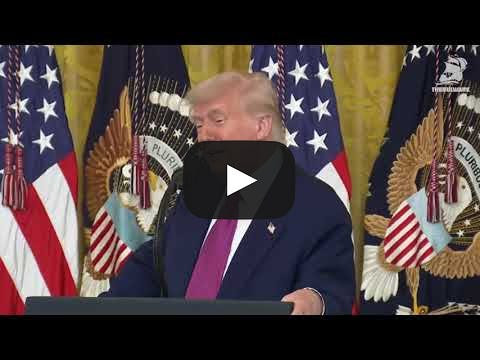
A commencement ceremony at California State University, Fullerton, in 2021.
Credit: Cal State Fullerton/Flickr
- New “K-12 Simplified Funding Program” is effectively an elimination, advocates say.
- Proposal eviscerates programs for low-income students in both K-12 and higher education.
- Funds for disabled students increased, but shift to flat funding is concerning to educators.
The Trump administration is proposing the biggest cuts in a half-century to federal financial aid by reducing Pell Grant award amounts for low-income college students, plus the government’s contribution to the Federal Work-Study program. Fewer students will likely enroll in college and achieve a degree as a result, college officials say.
The cuts are included in a proposed 15% reduction to the U.S. Department of Education’s budget, totaling $12 billion in cuts to K-12 and higher education, plus sweeping changes to how remaining funding would be distributed.
The president’s initial budget, issued on May 2, foreshadowed programs in danger of cuts or eliminations, but specifics remained vague until late last week with the release of new details.
The budget is still under review by the Senate, which could change the administration’s proposal in any direction.
Advocates, however, remain pessimistic and warn that this education budget request is only one aspect of the larger budget and policy concerns.
“The biggest thing is what happens in the Senate with budget reconciliation,” said Rob Manwaring, a fiscal and policy analyst at the advocacy organization Children Now.
The proposal eviscerates funding for programs that support students experiencing homelessness, rural students, English learners, and more. However, President Donald Trump would maintain Title I, which provides supplemental funds to schools in neighborhoods with concentrated poverty, at the current $18 billion.
K-12 funding
Funding for the Individuals with Disabilities Education Act (IDEA) is slightly higher in the budget request, but advocates are concerned that federally mandated costs are rising faster than federal funding.
Manwaring said special education, for instance, is “one of the fastest growing costs for school districts,” due to a rise in students being screened and diagnosed with disabilities, plus costs associated with the resources provided.
The budget request lists funding for special education as an “increased investment,” but a consolidation of various programs supporting students with disabilities ultimately amounts to flat funding.
This type of funding “is further reducing the federal government’s role in supporting special education” because it does not account for variables such as cost-of-living increases, costs of salaries and benefits for educators, a rise in disabled student populations, and other such changes, Manwaring said.
At risk of elimination are hundreds of millions for programs that support the education of migrant students, teacher training, education research and English learners.
The proposal includes pooling together 18 grant programs currently funded at about $6.5 billion into a single $2 billion block grant. It is titled K-12 Simplified Funding Program and the administration argues it will allow states and local education agencies flexibility in how funding is allocated.
Those 18 programs include:
- Education for Homeless Children and Youths (EHCY)
- Assistance for Arts in Education
- Statewide Family Engagement Centers
- American Civics and History Education
- Comprehensive Literacy State Development
Advocates say the consolidation amounts to elimination.
“It’s just another way of saying ‘we’re eliminating funding,’” said Barbara Duffield, executive director of SchoolHouse Connection. “Whether the funding is zeroed out because the line item is zeroed out or whether it’s zeroed out because supposedly it’s put into a new block grant, the program doesn’t exist anymore.”
Part of the problem with the consolidation plan is the removal of targeted funding, she added.
California’s Local Control Funding Formula, or LCFF, provides an example of how the federal consolidation plan could play out: While schools receive funding for several vulnerable student groups, the stream is not only often limited in how it can be spent, but is also shared among students with widely varying needs. This has historically led to insufficient funding for students who require much greater support, according to the Learning Policy Institute.
Lack of targeted funding for vulnerable student groups, such as students experiencing homelessness, fails to address the specific types of support that students may need in order to keep attending school, Duffield added.
“Who’s doing the outreach and awareness? Who’s going knocking on the doors of motels? Who’s going to shelters?” she asked, listing a multitude of tasks that homeless liaisons, funded in part with federal dollars, take care of.
Students experiencing homelessness are one student group with a specific federal policy outlining supports that schools are required to offer. In their case, it’s the McKinney-Vento Homeless Assistance Act.
Advocates are raising questions about whether the proposed funding changes could impact other federal policies.
“Will the requirement go away if the funding goes away? That is where the ambiguity of what the information that’s been shared so far is: Will there be changes in law that accompany changes in budget?” Manwaring said.
How higher education is faring
California college leaders said the proposed changes and cuts to federal financial aid programs, including TRIO programs, the Pell Grant, and federal work-study, would make it more difficult for students to enroll and complete their degrees.
TRIO programs — such as Upward Bound, Veterans Upward Bound, and McNair Post-Baccalaureate Achievement — aim to help disadvantaged students enroll in and complete college. Its funding, over $1 billion across 10 programs, would be fully eliminated.
In project year 2024-25, TRIO funded almost 450 projects in California, according to an EdSource analysis of grant award data for all eight TRIO program types published by the U.S. Department of Education. Together, projects in California received about $150 million to engage more than 100,000 student participants and train 556 staff members.
The White House proposal would also reduce the maximum Pell Grant by 23% — nearly $1,700 — from $7,395 to $5,710. The administration defends the proposed cut, saying that not reducing the maximum amount “would put the program in an untenable financial position,” and contends that the maximum award will still cover the average full amount of in-state tuition and fees for community college students. The budget summary says that overall funding levels have not kept up with broader eligibility requirements approved by former President Joe Biden.
The proposed cut to the Pell maximum grant is the first in more than 30 years and certainly the largest by far in the more than 50 years of the program’s existence, according to federal records. Very modest reductions to the maximum award were made in 1993 and in the early 1980s.
Additional changes imposed in the House’s reconciliation bill would strip any Pell Grant eligibility from many part-time students and change the number of minimum credits students need to get the maximum award from 12 credits per term to 15.
Such a large reduction in the maximum grant would be “troubling” and, together with the possible eligibility changes, would mostly impact low-income students and shut off more of them to the financial aid they need to attend college, said Allie Bidwell Arcese, senior director of strategic communications and engagement for the National Association of Student Financial Aid Administrators.
In California, 24% of community college students, 35% of University of California undergraduates and about 42% of California State University students receive a Pell Grant, which is available to low-income students.
The White House proposal would also reduce funding for Federal Work-Study by $980 million and eliminate the Federal Supplemental Educational Opportunity Grant. Those changes would be less impactful to California students but still significant. To employ students in work-study jobs, colleges would have to put up 75% of their pay; currently, they contribute only 25%. With both the CSU and UC already facing cuts in federal and state funding for next year, it’s unclear whether they could afford such an increase in matching money to sustain work study at current levels.
More than 41,000 students in California participated in the Federal Work-Study program in the 2022-23 award year, according to an EdSource analysis of Federal Student Aid data. Their earnings include almost $95 million in federal compensation.
In addition, more than 252,000 California students received Federal Supplemental Educational Opportunity Grants. The federal share of those awards was about $131 million.
In the San Diego Community College District, more than 12,000 students receive a Pell Grant. The proposals put forth in the White House’s budget request and the House reconciliation bill would have devastating impacts on the district’s students, said Chancellor Gregory Smith.
Roughly 4,000 students in the district get the maximum award and would lose out on about more than $1,500 annually. An additional 4,500 students take fewer than eight credits and could forgo their Pell Grants entirely under the House’s bill. Smith said he expects many of those students will end up dropping out if the proposed changes are enacted.
“The likelihood of many of them being able to complete college would be very low,” he said. “So many of our students are in difficult financial circumstances. One bad break — car breaks down — or a medical emergency — will likely force them to have to stop their education.”
At CSU, where more than $1 billion in Pell Grants was distributed to more than 200,000 students in 2023-24, officials estimate that 60% of Pell recipients would see their awards reduced or eliminated altogether under the White House proposal.
A number of CSU students also stand to lose out if the cuts to the opportunity grants and work-study are enacted. Almost 40,000 students were awarded the opportunity grants, and 6,300 participated in Federal Work-Study in 2023-24.
At UC, students and officials in recent years have advocated for the maximum Pell Grant to be doubled, arguing that the current ceiling for the award doesn’t meet student needs and forces many to take out loans. UC was thus “deeply concerned” about the White House proposal, said UC spokesperson Omar Rodriguez, particularly as the system also deals with disruptions to federal research funding.






